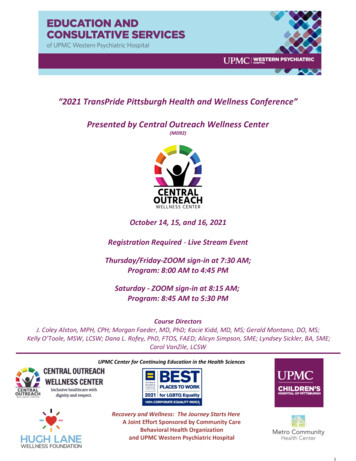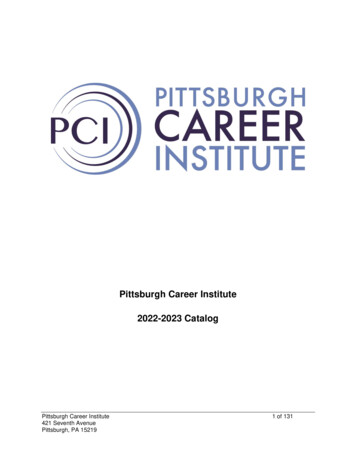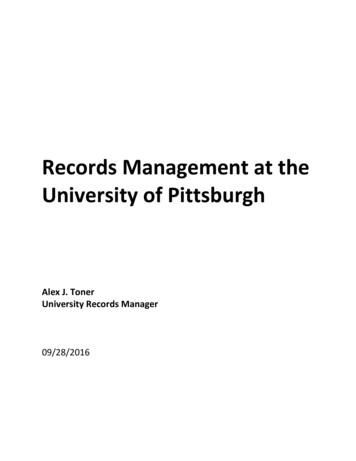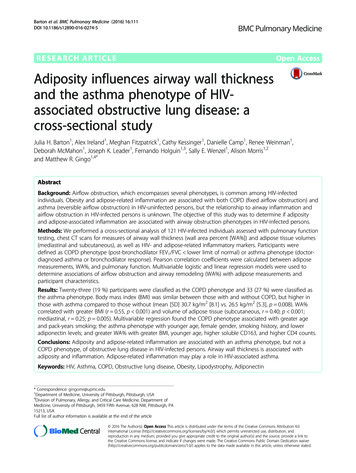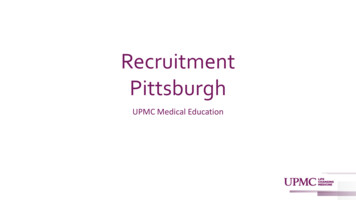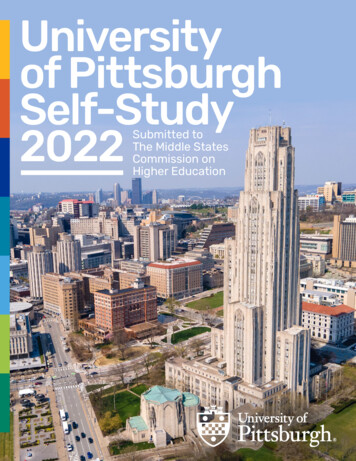
Transcription
Universityof PittsburghSelf-Study2022Submitted toThe Middle StatesCommission onHigher Education
ExecutiveSummaryThe primary purpose of this self-study report is to advance institutionalself-understanding and self-improvement. The secondary purpose of theself-study is to demonstrate to external audiences, such as the Middle StatesCommission on Higher Education, government regulatory agencies, and thepublic, that the institution meets the Commission’s standards for accreditation.The University of Pittsburgh is stronglysearching for new leadership; three of the fourcommitted to educating students,regional campus have appointed new presidentsadvancing knowledge and creativity andand two (Bradford and Titusville) have adoptedcontributing to the community and world. Thecombined leadership.University champions a progressive, inclusive, andcollaborative culture; fosters the lasting affinityof individuals to one another; values agility inoperational excellence; ensures outstandinginfrastructure; and nurtures and has achieved afinancially secured future.Student enrollment on all five campuses totalsThe University has been named a “top producer”of Fulbright scholars 10 times in 11 years.In 2013, the University founded the InnovationInstitute to advance Pitt’s successes inentrepreneurship, commercialization, andapproximately 25,000 undergraduate studentseconomic development. The U.S. Small Businessand 9,000 graduate and professional students.Administration named Pitt’s Small BusinessThere are more than 4,000 full-time, and aboutDevelopment Center (SBDC) the national SBDC900 part-time, faculty members and more thanExcellence and Innovation Award winner of 20207,000 staff members who support the work of theout of more than 1,000 small business developmentUniversity. The University’s alumni number morecenters across the nation.than 340,000.The University of Pittsburgh was first accreditedThe School of Computing and Information,formed in 2017, was created by combining theby the Middle States Commission on HigherUniversity’s School of Information Sciences andEducation in 1921. Accreditation was last reaffirmedthe Department of Computer Science.on November 16, 2017; the most recent decennialreaffirmation of accreditation was in June 2012.Since the most recent decennial review, theLaunched in 2018, the Office of Sustainabilitywas established to centralize campus-widesustainability activities, strategies, andUniversity has undergone substantial change, butpartnerships, driving toward aggressivehas also made tremendous strides. Leadershipsustainability commitments including being carbonacross the institution has changed, including theneutral on the Pittsburgh campus by 2037.appointment of Patrick D. Gallagher as ChancellorIn February 2019, the University launched itsin 2014 following the retirement of long-termPitt Success Pell Match Program, the largestChancellor Mark A. Nordenberg; Ann E. Cuddrestructuring of financial aid in the University’sbecame the Provost and Senior Vice Chancellorhistory. This program has had a significantin the fall of 2018; 12 of the 15 schools on thepositive impact on student success metrics for thePittsburgh campus have welcomed new deans,University’s lower-income students.while the remaining three are in the process of2HIGHLIGHTSUNIVERSITY OF PITTSBURGHThe University was awarded the prestigious
ExecutiveSummaryCarnegie Foundation’s Classification forCommunity Engagement in January 2020.The University recently launched the Bachelor ofScience in Public Health. The University’s School4. Enhance the University’s efficiency byincreasing alignment between resourceallocation and the goals and prioritiesof the strategic plan.of Public Health is now the sixth of the Pittsburghcampus schools to admit first-year students.5. Establish a well-defined baseline ofattainment of our priorities as well asTHE PATH AHEADWith a substantial focus, since the most recentaspirational, but realistic targets forthe path forward.reaffirmation, on guiding the University’s pursuitof our mission through the Plan for Pitt, theAs noted, the University has chosen to take ainstitution has chosen to take a priorities-basedpriorities-based approach to its self-study. Asapproach to the self-study process—focusingsuch, most Commission Standards, as well ason inclusive excellence in education, embracingthe Requirements for Affiliation, are addressedtoday’s world: local to global, foundationalwithin the respective sections focused on eachstrength: a commitment to sustainable excellence,of the four priority areas of this document. Aand research and innovation. This approachcross-walk identifying which of the standards/criteria/requirements are to be addressed withineach priority discussion is included within thedocument’s Table of Contents.has allowed the institution to address all of theaccreditation standards while engaging theUniversity community in focused reflection onpriorities for which they have a deep and abidingThe standards and requirements that are notpassion. Moreover, by concentrating on ansufficiently discussed within the priority chaptersauthentic and in-depth assessment of the currentare accounted for within a single additionalstate of the University with respect to thesechapter. There is documentary evidence availablefour priorities, Pitt has been able to achieve thein support of each standard/criteria/requirementfollowing over-arching outcomes within the self-listed at the end of each chapter.study process:During this reflective examination of the1. Demonstrate how the University ofUniversity, we have identified several corePittsburgh meets the Middle Statesstrengths, but also some opportunities foraccreditation standards, requirements ofinnovation and continuous improvement.affiliation and verification of compliancewith accreditation-relevant federalregulations.A DATA-DRIVEN CULTUREA culture dedicated to assessment has beenpervasive at the University for more than a decade.2. R educe barriers to intercampusIdentifying areas of improvement and acting uponcollaborations by engaging all campusesthose assessments has allowed the institution toin an inclusive and transparent self-reach record-setting retention and graduationappraisal process.outcomes nearly every year.Moreover, the University’s data-driven approach3. Translate best practices across the3to fostering student success for lower-incomeUniversity in focusing on continuousstudents has resulted in a model program in theimprovement in the attainment of itsPitt Success Pell Match initiative that will continueinstitutional priorities.to impact our community for years to come.UNIVERSITY OF PITTSBURGH
ExecutiveSummaryOPPORTUNITIESAt the same time, some ongoing opportunities forthat is representative of our region and nationis laudable. While this issue is being furtherinnovation have been identified within the evaluationaddressed through the launch of the new Universityof facilities. The campus master plan addressesEducational Outreach Center and through hiringthese opportunities over the coming years.and retention initiatives such as the Race and SocialSimilarly, the partnership with Purdue-Gallup hasDeterminants of Equity, Health and Well-beingspurred the launch of a directed culture of studentand Latinx Cluster Hire program, all are recentsupport that continues to grow and expand — acrossendeavors that will require sustained attention andstudent career levels and campuses — but consistentcommitment in order to achieve our goals.application of these practices must similarly expand.The University’s aim to host a community—within its student, staff, and faculty populations—4UNIVERSITY OF PITTSBURGHThese and other challenges examined indetail within the self-study truly are viewed asopportunities. At Pitt, progress is always in progress.
Table ofContentsRequirementof AffiliationStandard(Criterion)1 Introduction6History and Overview of the University of Pittsburgh1, 2, 126Institutional Mission and Priorities79Self-Study Approach and Rationale10Actions and Updates Since the Prior Self-Study102 Unallocated Standards and Requirements12Introduction12Requirements of Affiliation (RA)121, 2, 4, 5, 6, 12, 13, 14Standards and Criteria3(7), 4(2,3,5)3 Inclusive Excellence in Education1317Design1(3), 2(2), 3(1,2,5), 4(4), 5(3)20Delivery2(2), 3(1,2,4), 4(1,4), 5(3)23Support2(2,3,7), 3(2,4,5,6), 4(1,4), 5(3)27Assessment2(6,8,9), 3(2,8), 4(6), 5(1,2,3,5), 6(1,2)368, 9, 154 Embracing Today’s World: Local to Global41Strengthening Communities101(1,3,4), 2(7), 3(2,4,5), 4(1), 5(3)44Embracing the World7, 101(1,3,4), 2(2,4,5), 3(1,2,4,5,6), 4(1), 5(2,3)48Promoting Diversity and Inclusion81(1), 2(2,6), 3(2,5), 5(3)535 Foundational Strength: A Commitment to Sustainable Excellence58Place81(1), 2(2,3), 3(4,5), 5(3), 6(1,2,3,4,5,6,8,9)60People/Culture101(1,2,3,4), 2(2,3,7), 4(1,6), 5(3), 6(4)70The Intersection of People and Place8, 9, 101(3), 2(1,2,3,4,5,7,8,9), 3(3,8), 4(6),755(3), 6(1,2,3,4,5,7,8,9), 7(1,2,3,4,5)6 Research and InnovationDomains of Knowledge831(1)85Impact89Change in Research9052(1,2,4,9), 3(1,6), 4(1), 5(3), 7(5)7 Opportunities for Improvement and Innovation5PageNo.UNIVERSITY OF PITTSBURGH97
1. IntroductionHistory and Overview ofthe University of Pittsburghaccess by offering an excellent undergraduateexperience across a range of aspirations, abilitiesand interests. The 132-acre Pittsburgh campus isThe University of Pittsburgh, founded in 1787, is6located in the City of Pittsburgh’s educational andone of the oldest institutions of higher educationmedical center neighborhood, is within a one-in the United States. As one of the nation’shour commuting distance of the metropolitandistinguished institutions of higher education,area’s 2.4 million people and offers certificate,the resources of the University constitute anbaccalaureate, master’s, first professional, andinvaluable asset for the intellectual, economic,doctoral programs delivered both through in-and social enrichment of Pennsylvania, while theperson and distance education. The Johnstowninternational prestige of the University enhancescampus, a four-year undergraduate college inthe image of Pennsylvania throughout theCambria County, serves the region at the foothillsworld. The University of Pittsburgh is part of theof the Allegheny Mountains, offering certificate,Commonwealth System of Higher Education and isassociate, and baccalaureate programs. Thea nonsectarian, coeducational, state-related, publicBradford campus also offers certificate, associate,research university. The University is the mostand baccalaureate programs at a four-yearcomprehensive educational institution in Westernundergraduate college located in the AlleghenyPennsylvania, enrolling approximately 34,000Mountains at the Pennsylvania-New York border.students. Through its five campuses, the UniversityThis campus largely serves the predominantlyis able to fulfill its commitment to studentrural areas of Western Pennsylvania and WesternUNIVERSITY OF PITTSBURGH
1. INTRODUCTIONNew York. The Titusville campus is similarlyare nonvoting members of the Board althoughlocated in Northwestern Pennsylvania and isthey may vote as members of their individuala two-year college that offers only associatecommittees. The Governor of Pennsylvania, theprograms. Finally, the Greensburg campus is aCommonwealth Secretary of Education, the Chieffour-year undergraduate college located east ofExecutive of Allegheny County, and the Mayor ofPittsburgh that serves Westmoreland County andthe City of Pittsburgh serve as ex-officio membersthe Eastern Pittsburgh areas and offers certificatewithout voting rights. The Board of Trusteesand baccalaureate programs. In total, the Universityoversees the affairs of the University and promotesoffers more than 440 distinct degree programsits charitable, scientific and educational purposes.and numerous dual, joint, and cooperative degreeSpecific responsibilities include the approval of theprograms. Student enrollment on all five campusesUniversity mission; the recruitment, appointmenttotals more than 25,000 undergraduate studentsand evaluation of the Chancellor; promoting andand approximately 9,000 graduate and professionalprotecting the University’s independence, academicstudents. More than 4,000 full-time, and about 900freedom, and integrity; and stewardship of thepart-time, faculty members, approximately 1,000University’s resources and assets for the benefitresearch associates and post-doctoral associates,of future generations of students and society atand more than 7,000 staff members support thelarge. The Board of Trustees delegates generalwork of the University. The University’s alumniadministrative, academic, and managerial authoritynumber more than 340,000.to the Chancellor of the University. The Provost andThe Commonwealth of Pennsylvania uses aSenior Vice Chancellor is responsible for generalmodel of financing for state-related universitiesacademic policies and standards, and for overallthat relies heavily on tuition revenues offset byacademic matters in all schools and colleges, regionaldirect state aid to students. As a state-relatedcampuses, and centers. Schools of the health sciencesuniversity (since 1966), Pitt receives an annual,report to the senior vice chancellor for the Healthnon-preferred, financial appropriation from theSciences. Each of the regional campuses is governedCommonwealth of Pennsylvania. The annualby a campus president (Titusville and Bradfordappropriation from the commonwealth accountshave one president) who reports to the Provost. Thefor close to one twelfth of total revenues andbudget of the campuses as well as matters regardingenables the University to offer discounted tuitionacademic and faculty affairs are administered underto residents of the commonwealth. While thisthis organizational relationship.model of state support necessitates a tuition rateThe Pittsburgh campus comprises 16that is among the highest in the country amongundergraduate, graduate and professionalpublic institutions, it is still far below typicalschools including: the Kenneth P. Dietrich Schooltuition rates at private universities. Through itsof Arts and Sciences; School of Computing andstatus as a state-related institution, the UniversityInformation; School of Dental Medicine; Schoolretains much of its own autonomy as the Board ofof Education; College of General Studies; SchoolTrustees of the University is empowered to makeof Health and Rehabilitation Sciences; Universityall academic and operational decisions regardingHonors College; Joseph M. Katz Graduate School ofits governance. The complete membership of theBusiness and College of Business Administration;Board includes the Chancellor and five categoriesSchool of Law; School of Medicine; School ofof trustees: Term (currently 16 out of a possibleNursing; School of Pharmacy; Graduate School17); Alumni (6); Commonwealth (currently 11of Public Health; Graduate School of Public andout of a possible 12) ; Special (currently 15 outInternational Affairs; School of Social Work;of a possible 16); and Emeriti (33). Currentlyand the Swanson School of Engineering. Thethere are 82 members of the Board. Term,University is affiliated with, but distinct from, theAlumni and Commonwealth trustees as well asUniversity of Pittsburgh Medical Center (UPMC),the Chancellor represent the 36 possible votingan integrated global health enterprise and one ofBoard members. Special and Emeriti trusteesthe nation’s leading academic health care systems.7UNIVERSITY OF PITTSBURGH
1. INTRODUCTIONThe regional campuses are organized into divisionsremaining three of in the midst of searches. Threethat vary slightly by campus, but generally focusof the four regional campus have appointed newon Business, Behavioral/Social Sciences, NaturalPresidents, and two (Bradford and Titusville)Sciences, Nursing, Engineering, Education, andhave combined leadership.Humanities.Pitt is a member of the Association of American· Each year, the Chronicle of Higher EducationUniversities and ranks in the very top cluster ofreleases names of the colleges and universitiesU.S. public research universities, according to Thethat produce the most award recipients in theCenter for Measuring University Performance. TheFulbright U.S. Scholar and the Fulbright U.S.University is ranked No. 20 among the nation’sStudent Programs. In 2021 it is the tenth time intop public colleges and universities in the 2021 U.S.11 years that the publication listed Pitt as a topNews & World Report Best Colleges rankings. Pittproducer in the U.S. Student Program category.also ranks 9th nationally in federal science andengineering funding, attracting approximately· The University was awarded the Carnegie 750 million annually and was among the top fiveFoundation’s Classification for Communityin National Institutes of Health funding in 2019.Engagement in January 2020. This classificationRecent societal and health issues have posedis known as the country’s most visible andchallenges for the University. The COVID-19selective recognition of community engagementpandemic challenged the way the University works,efforts in higher education. This designationeducates its students and conducts research andrecognizes the hard work of the University’sthe University continues to evolve its response tostudents, faculty and staff who invest theirthis reality. Racial injustice and inequity are greatservice, research and teaching in the community.challenges for society and for the University ofThe establishment of two CommunityPittsburgh. Since 2020 the University has takenEngagement Centers, located in neighborhoodsconcrete steps to help address the issues of equitysurrounding the Pittsburgh campus, is anand justice on all Pitt campuses and to make Pittexample of the University’s focus to improvea more inclusive environment, with a specificengagement with local communities throughemphasis on equity for Black people. Funding fromlong-term partnerships.the Commonwealth of Pennsylvania remains flatwhich has resulted in an increase in student debt.· In February 2019, the University launched its PittAlso, a series of reports describing a ‘demographicSuccess Pell Match Program, the largest-evercliff’ or a drop in the number of traditional college-restructuring of financial aid in the University’sage population especially in the northeast andhistory. Under this program, the UniversityMidwest is an ongoing concern, particularly formatches federal Pell Grant funds, dollar forthe University’s regional campuses. Despite thesedollar, up to the cost of attendance for qualifiedfiscal challenges, the University remains on a solidstudents across all five Pitt campuses. In itsfoundation.first year, the program virtually closed theThere have been a number of initiatives andretention gap for students eligible for the U.S.notable changes since the last successful MiddleDepartment of Education’s Pell Grant programStates accreditation in 2012. Examples include:and student success metrics for this population· T he University has undergone a substantialremain strong.change in leadership. Patrick D. Gallagher wasappointed Chancellor in 2014 following theretirement of long-term Chancellor Mark A.8· Launched in 2018, the Office of Sustainabilitywas established to centralize campus-wideNordenberg. Ann E. Cudd became the Provost andsustainability activities, strategies, andSenior Vice Chancellor in the fall of 2018. Sincepartnerships, driving toward aggressive2012, twelve of the 16 schools on the Pittsburghsustainability commitments including beingcampus have welcomed new deans and thecarbon neutral on the Pittsburgh campus by 2037.UNIVERSITY OF PITTSBURGH
1. INTRODUCTION· The School of Computing and Information,formed in 2017, was created by combining theinstitutions to transfer knowledge in science,technology, and health care;University’s School of Information Sciences andthe Department of Computer Science. It was theUniversity’s first new school in two decades. offer continuing education programs adaptedto the personal enrichment, professionalupgrading, and career advancement interests· In 2013, the University founded the Innovationand needs of adult Pennsylvanians; andInstitute to advance Pitt’s successes inentrepreneurship, commercialization, andeconomic development. The U.S. Small Business make available to local communitiesand public agencies the expertise of theAdministration named Pitt’s Small BusinessUniversity in ways that are consistent withDevelopment Center (SBDC) the national SBDCthe primary teaching and research functionsExcellence and Innovation Award winner ofand contribute to social, intellectual,2020 out of more than 1,000 small businessand economic development in thedevelopment centers across the nation.commonwealth, the nation, and the world.Institutional Mission and PrioritiesSpecific goals related to the mission have beenperiodically updated through broad stakeholderengagement several times since the most recentThe University of Pittsburgh is strongly committedself-study, including an update from the Boardto educating students, advancing knowledge andof Trustees in 2014 and subsequent refinement bycreativity, and contributing to the community andthe entire University community with the 2015 andworld. The University champions a progressive,2021 versions of the institution’s strategic plan, theinclusive, and collaborative culture; fosters thePlan for Pitt. Additionally, several associated sub-lasting affinity of individuals to one another;plans (focused on sustainability, campus mastervalues agility in operational excellence; ensuresplan, global plan, etc.) are periodically reviewedoutstanding infrastructure; and nurtures andand updated.achieves a financially secured future. The UniversityThe priorities of the University examined in theof Pittsburgh’s Mission Statement was most recentlycurrent self-study, that are consistent with themodified/approved by the Board of Trustees onPlan for Pitt and inform the pursuit of our missionFebruary 16, 1995, and aims to:include:· provide high-quality undergraduate1. Inclusive Excellence in Education: theprograms in the arts and sciences andUniversity aims to foster a supportive andprofessional fields, with emphasis uponinclusive educational environment thatthose of special benefit to the citizens ofis focused on holistic and individualizedPennsylvania;approaches to learning both inside andoutside the classroom that empowers our o ffer superior graduate programs in the artsstudents to lead lives of impact.and sciences and the professions that respondto the needs of Pennsylvania, as well as to thebroader needs of the nation and the world;2. Embracing Today’s World: Local to Global— the University strives to build and sustainthe capacity to partner with communities, engage in research, artistic, and scholarlybased on mutual trust and reciprocity,activities that advance learning through theto expand knowledge, economic growth,extension of the frontiers of knowledge andequity, and justice. The University aspirescreative endeavor;to embody diversity and inclusion bycontinually assessing our broad community cooperate with industrial and governmental9 UNIVERSITY OF PITTSBURGHand attuning efforts accordingly; to creating
1. INTRODUCTIONand maintaining space for open dialogue onaffirmed the approach during its discussion of theour varied perspectives, embracing a culturedraft Self-Study Design. The consensus among theof belonging for persons of all identities andSteering Committee and the University leadershipabilities, and conducting all aspects of ourwas that a priorities-based approach would alloweducation, research, hiring, and businessthe institution to address all of the accreditationpractices in a just and equitable manner.standards while engaging the UniversityThe University is committed to fosteringcommunity in focused reflection on prioritiesa campus culture with a global mindset;for which they have a deep and abiding passion.to convening bright and creative minds toBy concentrating on an authentic and in-depthaddress global challenges and improve life inassessment of the current state of the Universitythe world’s local communities.with respect to these four priorities we havenot only provided a measure of the institutional3. Foundational Strength: A Commitment toadvancement achieved during the first Plan forSustainable Excellence — the UniversityPitt period, but also have identified best practicesleverages its physical and humanwithin the University and set a baseline for bothinfrastructure to support its mission,formative and summative evaluation of ourincluding enhancing the student experience.progress during our next strategic phase. Finally,The University values and ensuresby enlisting a wide range of University stakeholdersoperational excellence and agility, andin the process of self-study, we have establishedachieves this by creating and sustainingthe broad participation that is necessary to instilloutstanding technology, information, andcollective ownership while also empoweringphysical plant infrastructure that aligns withchampions/stewards of our shared vision acrossour sustainability goals while achieving athe University. In this way, our self-study processfinancially secure future.has served, not as a chore or even a measuringstick, but instead as a launching pad to accelerated4. R esearch and Innovation: the Universityaims to extend the boundaries of knowledgeattainment of impact in these critical areas thatbroadly affect all units of the institution.and drive new areas of inquiry; to addresscomplex problems and great societalchallenges; and to positively impact the worldthrough collaboration within and acrossActions and Updates Since thePrior Self-Studydisciplines as well as advancing research,innovation, and creative expression.On May 22, 2019 and then again on March 5,2020 the Middle States Commission on HigherSelf-Study Approach and RationaleEducation (MSCHE) requested a supplementalinformation report to address the status ofthe Physical Therapy Assistant program at theThe University of Pittsburgh has chosen aUniversity of Pittsburgh at Titusville (UPT) withpriorities-based approach. This approach wasthe Commission on Accreditation in Physicalinitially proposed by three members of theTherapy Education (CAPTE). Shortly before theExecutive Committee after they attended the Self-requested report, CAPTE had changed its standardsStudy Institute in fall 2019. In Pitt’s last successfulfor licensure passage rates from requiring a three-self-study in 2012 a topic-based approach —year running average of 80% exam success to afocusing on assessment — was used and it wastwo-year running average of 85% success. Givendecided that it would be effective for Pitt to buildthe small size of the cohorts on the UPT campus,on that experience. The proposed, priorities-basedand the concomitant volatility in testing results, itapproach was positively received and approvedwas determined that the program would be unableby the Provost. Similarly, the Steering Committeeto ensure consistent adherence to this standard.10UNIVERSITY OF PITTSBURGH
1. INTRODUCTIONIn addition, changes to the CAPTE requirements ofEvidence Inventory) in the summer of 2020 andprogram director credentials made it exceedinglythe substantive work of self-study began, anddifficult to maintain effective staffing of thecontinued as follows:program. As such, Pitt chose to voluntarilywithdraw accreditation for the PTA program atUPT, to develop a detailed teach-out plan for allstudents who were enrolled in the program at thetime, and to formally close the program by Augustof 2021. Since that time, the teach-out has beensuccessful, and the program has been closed.Fall 2020· Steering Committee meets to discussand approve Self-Study Design· Self-Study Design submitted· MSCHE conducts preparation visit· Self-Study Design acceptedOn November 9, 2020, the Middle StatesCommission on Higher Education (MSCHE)requested a supplemental information report toaddress an investigation by the U.S. Department ofFall—Spring 2021· Working Groups meet according to varyingschedules (and engage with UniversityEducation (USDE) of the University of Pittsburgh.stakeholders during their discovery phase)Shortly after the requested report, Pitt responded· Working Group Chairs update the Steeringto the USDE clarifying that the disputed actionsCommittee monthlywere undertaken by the operationally distinctcorporate entity UPMC and impacted a facultymember’s non-academic role performed in ajoint-employment arrangement. As such, Pittclarified that the academic freedoms enjoyed by thefaculty member within their University-employedSpring—Summer 2021· Priorities Working Groups submit reports tothe Steering Committee· MSCHE selects Evaluation Team Chair· Team Chair and the University select dateseducational and research role were not negativelyfor the Evaluation Team Chair’s preliminaryimpacted and were, in fact, reaffirmed throughoutand Evaluation Team visitthe incident. In the time subsequent to theresponse from Pitt (more than 1 year), the USDEhas not responded with any additional questionsor concerns.Timeline of the Self-Study ProcessSummer—Fall 2021· Steering Committee develops draft Self-Study· University community reviews draft Self-Study· Board of Trustees Academic Affairs/LibrariesCommittee reviews draft Self-StudyWinter 2022The Self-Study process began with members· Executive Committee incorporates feedback andof the Executive Committee attending the Self-finalizes mapping of Self-study and EvidenceStudy Institute in November 2019. Then, in SpringInventory2020, the University began the formation of theSteering Committee and the process of confirming· University submits Self-Study, Evidence Inventory,and Institutional Federal Compliance Reportthe approach to be ta
UNIVERSITY OF PITTSBURGH. Table of . Contents. Requirement . of Affiliation Standard (Criterion) Page. No. 1. Introduction. 6 History and Overview of the University of Pittsburgh 1, 2, 12 6. Institutional Mission and Priorities 7 9. Self-Study Approach and Rationale. 10. Actions and Updates Since the Prior Self-Study. 10. 2. Unallocated .
